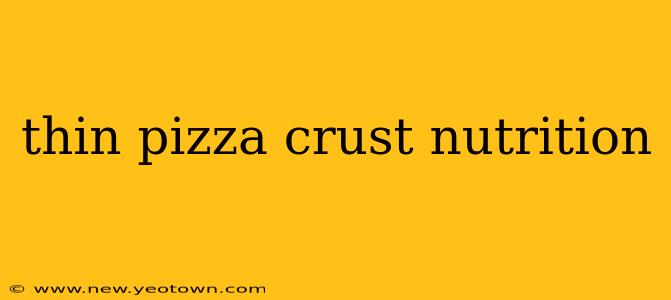Let's be honest, pizza is a guilty pleasure for many. But what about those of us trying to eat a little healthier? Does choosing a thin crust pizza really make a difference in terms of nutrition? The answer, like a perfectly cooked pizza, is complex, layered, and surprisingly nuanced. It's not a simple yes or no, but rather a careful examination of the ingredients and portion sizes.
This journey into the world of thin crust pizza nutrition begins with the understanding that not all thin crusts are created equal. The nutritional value depends heavily on the type of flour used, the added oils and fats, and even the cooking process. Think of it like choosing your pizza toppings – the crust is just the base, and the rest can dramatically alter the nutritional profile.
What Makes Thin Crust Pizza Different Nutritionally?
A thin crust pizza, generally speaking, contains fewer calories and less carbohydrates compared to its thicker, deep-dish counterparts. This is primarily due to the reduced amount of dough used. Less dough translates to fewer grams of carbohydrates and, consequently, fewer calories. This is particularly appealing to those watching their weight or carbohydrate intake.
However, let's not get carried away. While the crust itself might be lower in calories and carbs, the toppings still play a significant role. A thin crust pizza loaded with pepperoni, extra cheese, and creamy sauces can easily negate the nutritional benefits of choosing a thinner base.
How Many Calories are in a Thin Crust Pizza?
This is the million-dollar question, and unfortunately, there's no single answer. The calorie count drastically varies depending on the size of the pizza, the type of crust (whole wheat, white, etc.), and especially the toppings. A small thin crust pizza with simple toppings could easily fall under 500 calories, while a large pizza laden with cheese and meats could exceed 1500 calories. Always check the nutritional information provided by the restaurant or pizzeria.
Is Thin Crust Pizza Better for Weight Loss?
Choosing a thin crust can be part of a weight-loss strategy, but it's not a magic bullet. The overall calorie intake is what ultimately matters. A small thin crust pizza with vegetable toppings is a much healthier option than a large, meat-heavy pizza, regardless of the crust thickness. Focus on portion control and healthy toppings to maximize the weight loss benefits.
What are the Nutritional Benefits of Thin Crust Pizza (Compared to Thick Crust)?
The primary benefit is the reduced calorie and carbohydrate content. A thinner crust generally offers less saturated fat as well, although this can again be influenced by the type of flour and added oils. This reduction in calories and fat can contribute to better blood sugar control and improved overall health for individuals seeking a healthier dietary approach.
What are the Ingredients in a Typical Thin Crust Pizza?
The main ingredients are typically flour, water, yeast, salt, and sometimes oil or other fats. Variations can include whole wheat flour for added fiber, or different types of oils like olive oil. The quality and type of flour significantly impact the nutritional value.
Is Whole Wheat Thin Crust Pizza Healthier?
Yes, generally speaking. Whole wheat flour contains more fiber than white flour, leading to improved digestion and increased satiety. The added fiber also contributes to a lower glycemic index, meaning a slower release of sugar into the bloodstream. This makes it a more suitable option for those managing blood sugar levels.
In conclusion, thin crust pizza can be a part of a balanced diet. The key lies in mindful choices regarding toppings and portion control. While the thinner crust offers a lower calorie and carbohydrate base compared to thicker options, the nutritional value hinges greatly on the ingredients and overall composition of the pizza. Don't let a thin crust deceive you – always make informed choices to enjoy pizza while keeping your health in mind.

